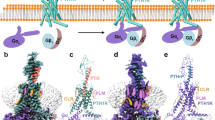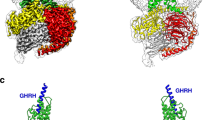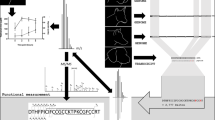Abstract
The rat calcitonin gene has recently been shown to encode a novel peptide (rat calcitonin gene-related peptide, rCGRP) thought to be produced in nervous tissue after tissue-specific RNA processing1,2. This peptide has so far been identified only in rat tissue, by immunocytochemistry and immunoassay. We now report the isolation of a related (89% homology) peptide from human tissue (hCGRP) which we have sequenced using a novel mass spectrometric approach, fast atom bombardment (FAB) mapping3–5. The human peptide differs significantly from the predicted rCGRP structure in four positions in the amino acid sequence (three effecting charge changes), and the presence of a disulphide bridge and an amide, surmised in the rat work, is proven in the hCGRP molecule. hCGRP was present in plasma from 10 patients with medullary thyroid carcinoma (MTC) and in 6 MTC tumours removed at surgery, suggesting the tissue distribution may differ from that in the rat where the peptide is reported to be absent from thyroid tissue2. hCGRP is shown to have biological activity and it is possible that its presence in MTC plasma may be responsible for some of the symptoms in this disease.
This is a preview of subscription content, access via your institution
Access options
Subscribe to this journal
Receive 51 print issues and online access
$199.00 per year
only $3.90 per issue
Buy this article
- Purchase on Springer Link
- Instant access to full article PDF
Prices may be subject to local taxes which are calculated during checkout
Similar content being viewed by others
References
Amara, S. G., Jonas, V., Rosenfeld, M. G., Ong, E.S. & Evans, R.M. Nature 298, 240–244 (1982).
Rosenfeld, M. G. et al. Nature 304, 129–135 (1983).
Morris, H. R. et al. Biochem. biophys. Res. Commun. 101, 623–631 (1981).
Morris, H. R., Panico, M., Karplus, A., Lloyd, P. E. & Riniker, B. Nature 304, 643–645 (1982).
Morris, H. R., Panico, M. & Taylor, G. W. Biochem. biophys. Res. Commun. 117, 299–305 (1983).
Fisher, L. A. et al. Nature 305, 534–536 (1983).
Bennett, H. P. J., Hudson, A. M., Kelly, L., MacMartin, C. & Purdon, G. E. Biochem. J. 175, 1139–1141 (1978).
Morris, H. R., Dell, A. & McDowell, R. A. Biomed. Mass Spectrom. 8, 463–473 (1981).
Barber, M., Bordoli, R. S., Sedgwick, R. D. & Tyler, A. N. Chem. Commun., 325–327 (1981).
Williams, D. H., Bradley, C., Bojesan, G., Santikara, S. & Taylor, L. C. E. J. Am. chem. Soc. 103, 5700–5704 (1981).
Morris, H. R., Etienne, A. T., Dell, A. & Albuquerque, R. J. Neurochem. 34, 574–582 (1980).
Author information
Authors and Affiliations
Rights and permissions
About this article
Cite this article
Morris, H., Panico, M., Etienne, T. et al. Isolation and characterization of human calcitonin gene-related peptide. Nature 308, 746–748 (1984). https://doi.org/10.1038/308746a0
Received:
Accepted:
Issue Date:
DOI: https://doi.org/10.1038/308746a0
This article is cited by
-
Calcitonin gene-related peptide alleviates hypertrophic scar formation by inhibiting the inflammation
Archives of Dermatological Research (2022)
-
Construction of calcitonin gene-related peptide-modified mesenchymal stem cells and analysis of their effects on the migration and proliferation of vascular smooth muscle cells
In Vitro Cellular & Developmental Biology - Animal (2020)
-
Is calcitonin gene-related peptide a modulator of menopausal vasomotor symptoms?
Endocrine (2019)
-
Role of calcitonin gene-related peptide in energy metabolism
Endocrine (2017)
-
The role of neuropeptides in adverse myocardial remodeling and heart failure
Cellular and Molecular Life Sciences (2017)
Comments
By submitting a comment you agree to abide by our Terms and Community Guidelines. If you find something abusive or that does not comply with our terms or guidelines please flag it as inappropriate.



